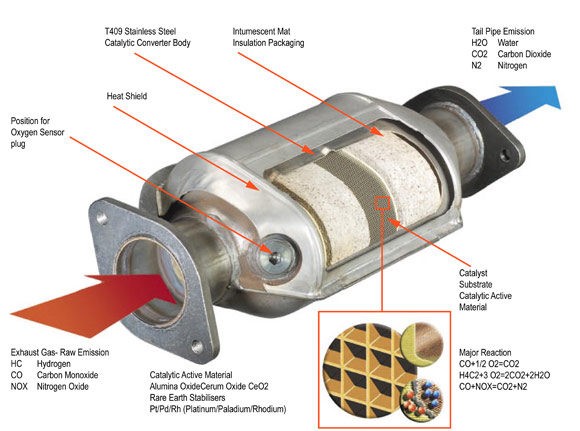- 10/10/2014
- 1 Min Read
- By: JR Huntington
Catalytic Converters: What Happens When They Go Bad?
The Catalytic Converter may not seem it, but it's much more than a piece of metal under your car. Hot exhaust gasses exit your engine and head down the exhaust system to the cat. Inside this there is a honeycomb structure made from ceramic and different types of precious metals. This structure is coated with compounds that react with the expelled exhaust, and make it cleaner for the environment. Even though the exhaust gasses are pushed through the pipe at high speeds, the above mentioned compounds react to the gases within milliseconds turning the noxious gas to something less harmful like Carbon Dioxide and water vapor.
What Does A Catalytic Converter Do?
The cat reduces these gasses and cleans them into cleaner safer gasses:
- Carbon Monoxide - Most used air leaving an engine is Carbon Monoxide, which is a deadly odorless gas. The cat creates a reaction between the CO and the surrounding air to create CO2 and H2O.
- Hydrocarbons - VOCs - Any compound made from carbon and hydrogen that can be burned. These are all made up of un-burned carbon and hydrogen.
- NOx - Most emissions failures have a high NOx reading. These are typically Nitrogen that is mixed with Oxygen that is expelled from the engine un-burned , creating smog etc.
How Does A Catalytic Converter Work?
The catalytic works in conjunction with the O2 sensors to clean the gasses. When everything is operating as it should and all the right parameters at set, i.e. air/fuel, operating temp. etc. - this should give you the cleanest possible exhaust. If you happen to have a faulty O2 sensor this can really start to create problems. The O2 sensor can alter your air/fuel mixture, and in the long run can cause premature damage to the cat. Too lean of a mixture, and you will not have the right properties to clean the gas. Too rich and you could heat the cat up to the point of glowing red hot causing the internal structure to melt. If you have a car that features the continual oil change (burns oil) or leaks coolant into the engine, these issues can lead to a clog as it will coat the internals of the catalytic converter, blocking its ability to expel the gas through the honeycombs. Keeping your car in top shape will help these issues to a minimum.
Once a cat reaches its optimal temperature roughly 400-600º Fahrenheit the coated internals begin to do their job. There are three types of "harmful" emissions gasses that are regulated by the EPA. These are CO (Carbon Monoxide) Hydrocarbons- VOC's (Volatile Organic Compounds) and NOX (Nitrogen Compounds). The compounds coating the innards of the cat remove most of the bad stuff and leave the expelled gasses much cleaner and safer.
What Are The Symptoms of A Bad Catalytic Converter?
A few signs of a cat actually being bad are as follows:
- Your vehicle’s fuel efficiency suddenly drops
- Your vehicle's acceleration diminishes slightly
- Your vehicle may refuse to start or choke itself out
- The vehicle has Higher than normal emissions levels
- The cat itself starts to glow red
- Your vehicle produces a strong sulfur smell
- Rattling from the cat itself
Remember: When replacing any exhaust parts such as your catalytic converter it's always a good idea to get the appropriate gaskets. I would also suggest replacing the pre and post oxygen sensors while you are there so you know your entire system is up to snuff. We offer a large selection of high quality exhaust for European cars. Feel free to reach out to us at service@fcpeuro.com if you have any questions regarding your exhaust, replacement parts, or simply need help diagnosing any issues.











